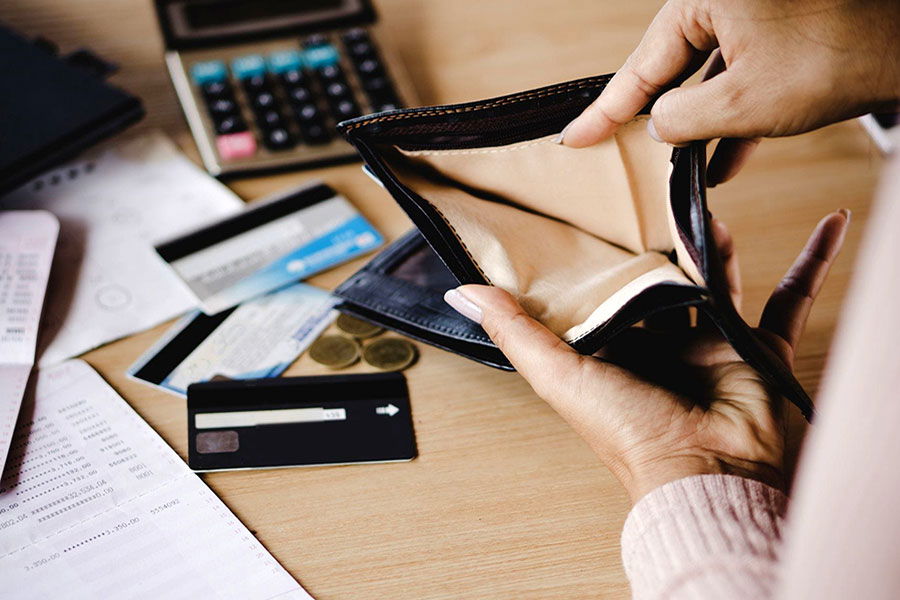If you’ve ever been strapped for cash and need money quickly, you may have considered taking out a payday loan. Whether you’ve seen a corner store offering loans with no credit checks or an online lender boasting fast funding times, be sure to look before you leap.

Even though payday loans come with several benefits, there are significant disadvantages to be aware of. Therefore, it’s worth considering other options to meet your financial needs. So, what kind of alternatives are there to payday loans? Keep reading to find out.
What is a payday loan?
Before diving into alternatives, understand what is involved with a payday loan. In short, it’s a small cash advance borrowed for a short period of time. The most common loan terms are two weeks because that’s how long it takes most people to receive their next paycheck.
Payday loans cover short-term needs like paying rent when your budget falls short or when an unexpected expense like a car repair pops up. Perhaps most appealing about them is there are very few requirements for approval, and most lenders don’t run a credit check.
Payday Loan Requirements
Consequently, you can have bad credit — or none at all — and still qualify. However, you will need to have a checking account and provide the lender with a check or account number in most cases.
The lender then automatically debits the amount you owe on the loan’s due date, plus whatever fees or interest are included. This helps protect the lender from losing out on money. If you don’t have the money in your account, you have the option to roll it into another term, along with another set of fees.
Payday Loan Debt Cycle
This is where payday loans get tricky. Many people quickly get stuck in a cycle of debt because they can’t pay the original amount owed. On top of that, they keep accumulating expensive fees every time they renew the loan.
What likely started as a loan to bridge a short-term financial need can quickly snowball into a long-term burden of debt. So be sure to have a solid repayment plan if you decide to take out a payday loan. Even better, consider using an alternative financing method.
Are payday loans bad?
Payday loans are expensive, and the way they’re structured can be deceptive. In the United States, each state has different rules about how much interest can be charged on a payday loan. But in most situations, you’ll typically pay somewhere between $10 and $30 for every $100 you borrow.
Usually, this amount needs to be paid back in two weeks. You might be thinking, “$20 isn’t much money to pay to get the cash I need to fix my car!” But let’s look at things in a different light.
High Interest Rates
Let’s say you borrow $300 to get your car worked on, and you’re charged $30 ($10 for each $100 borrowed). Your APR is actually more than 260% because the amount of interest you’re paying is extraordinarily high compared to the length of time for repayment and the loan amount.
Think about your credit card with the highest annual percentage rate (APR). No matter how high it is, it’s nowhere near 260%! When you put things into perspective, you can see that they are very costly.
Payday Loan Fees
Plus, that fee only applies to a single two-week repayment period. In actuality, most people are likely to roll over their loan, meaning they can’t repay the money by the original due date. A 2014 study from the Consumer Financial Protection Bureau discovered that 80% of payday loan borrowers renewed their loan after 14 days.
That leads to more fees and interest growing each time the loan is renewed, and an extremely dangerous (and expensive) cycle to get caught in.
Credit History
Payday lenders typically do not report your payment history to the three major credit bureaus, so you miss an opportunity to build your credit history. With personal loans and credit cards, your payment usually is reported to the credit bureaus.
9 Best Payday Loan Alternatives
There are many alternatives. Some are quick, some take more preparation time, and some require varying degrees of positive credit. But within this list, you’re sure to find something to help avoid getting a payday loan.
1. Tap Into Your Emergency Savings Fund
The best way to avoid having to take out a loan is to have a savings cushion for emergencies. This might not be an immediate solution to your problems, but it can be a game-changer in the long run. So start by saving up $1,000 for your emergency fund.
As an exercise in changing your perception of the definition of an emergency, keep the money in a bank account that’s difficult to get to. Then, don’t activate your online account. To get the money, you’ll need to make an inconvenient drive, causing you to think twice about whether you truly need it.
Anytime you use some or all of your savings, you should immediately begin repaying yourself. That way, you always have that buffer to hedge against a rainy day.
Once that’s taken care of, start building an even bigger financial safety net. This should typically amount to three to six months of your expenses. So if you lose your job or have hours cut back, you can still meet all of your financial obligations until your situation gets better.
2. Explore the Benefits of a Payday Alternative Loan (PAL)
A payday alternative loan (PAL) is a type of small, short-term loan offered by certain federal credit unions. It’s designed to provide an alternative to high-cost payday loans.
PALs typically have lower interest rates and fees than payday loans, and the terms are more flexible. They are available to members of participating credit unions who meet certain eligibility requirements.
According to the guidelines set by the NCUA, all payday alternative loans (PALs) must fall within the following parameters:
- Loan amounts must be between $200 and $1,000
- Borrowers must be a member of the federal credit union for at least one month
- Loan terms are one to six months
- An application fee of no more than $20 to cover processing costs
- No ability to roll over the loan
PALs can be used for various purposes, including covering emergency expenses, paying bills, or making small purchases. They are generally repaid over a period of several months, with the borrower making regular payments to the credit union.
3. Take Out a Personal Loan
Online lenders have made it easy to access funds quickly through personal loans. You can even find personal loans for bad credit. Unlike payday loans, these unsecured loans have a long term with consistent installment payments. They also have more reasonable collateral requirements, renewal limits, and only a single penalty fee for paying late.
Personal installment loans are much more consumer-friendly than payday loans. Plus, they give you a clear path to repayment since you know how much and for how long you’ll be making payments. On the other hand, payday loans are likely to catch you in an ongoing cycle of debt.
If you have trouble qualifying for a personal loan on your own, consider adding a cosigner. This allows you to add another person’s credit score and income to the loan application. It can potentially increase your chances of qualifying and with better terms. Just remember that any late payments and defaults you make on the loan will also impact your cosigner’s credit score.
Check Out Our Top Picks:
Best Online Personal Loans for 2025
4. Use a Credit Card
If you have a credit card that isn’t maxed out, consider using it for your financial emergency instead of a payday loan. Even if the APR is high, it’s unlikely to be higher than a payday loan, especially if you need more than two weeks to repay it.
If you don’t have a credit card you can use, consider applying for a new one. Online applications make the process relatively quick these days, and there are plenty of options for all credit types.
With bad credit, you’ll likely pay higher interest rates, but again, it’s still a better option. Most credit cards offer cash advances. However, the interest rate is higher than standard charges, but you can avoid it altogether by paying the balance before your next billing cycle.
5. Talk to Your Creditor
When you’re considering a loan to help pay off existing credit card debt, you should first talk directly to your bank or credit union. Explain your issues to them and see if they can help you out.
Credit card issuers may be able to give you a brief reprieve from making payments if your financial hardship is temporary. Or they could consolidate your debt to lengthen the repayment period and lower your monthly payment. Of course, you’ll end up paying more interest compared to the original payoff plan. However, you don’t have to worry about the added risk and expense of a payday loan.
6. Borrow Money from Friends and Family
Assuming you need cash now and can’t wait to save the money, consider asking friends or family. While this might not be the best option for some people, it does help you avoid expensive fees and potential damage to your credit scores.
Make sure you can repay the loan on time so that you don’t end up damaging a personal relationship. But if you and your friend or family member are both comfortable with the situation, it can be a low-cost or even free way to make ends meet.
Just be sure to draw up an agreement so that both of your expectations are on the same page. For example, will you pay interest on top of the amount owed? Does your friend expect the money to be repaid within a certain timeframe? Have a frank discussion, so no one is surprised. Be honest with your friend and yourself about how realistic the proposed payment plan is.
7. Look for Community Resources
Many local communities have financial resources available. You just need to ask. Check with your church or other community groups to see if any assistance is available. You can also check for government resources that are aimed to help people through financial hardships.
The SNAP program (similar to food stamps) and WIC both help to afford groceries each month, so you can spend your money on other obligations. You can also search for help from the government’s Low Income Home Energy Assistance Program. They can possibly help you lower your heating and cooling bills throughout the year.
8. Start a Side Hustle
One way to avoid taking out a loan is to sell some of your things or earn extra money, whether through a second job or side hustle. This idea can also help you put money in your bank account when you’re first getting started.
You probably won’t make millions going through your attic, but even just pulling together a few dollars here and there can help. If you have a marketable service, you can also advertise online and get friends to help spread the word. Alternatively, you can ask for extra hours at work to help fill a short-term financial need.
9. Contact a Credit Counselor
When you’re not sure how to get control over your finances and your life, it’s time to get help. A consumer counseling agency can help you review your financial situation and explore your options for moving forward.
This is especially helpful if you’re overwhelmed with debt and have trouble making your payments. Talk to a professional to develop a debt management plan that works for you.
Payday Loan Alternatives You May Want to Avoid
While there are several alternatives to payday loans that can help avoid the debt trap, it’s important to note that not all alternatives are created equal. Some can lead to further financial hardship, much like payday loans themselves. Here are a few payday loan alternatives you should avoid:
1. Title Loans
Title loans are similar to payday loans in that they offer fast cash without the need for a credit check. However, instead of using your paycheck as collateral, you use your car title. The lender holds the title to your vehicle until the loan is paid back in full, often with very high interest rates. If you can’t repay the loan on time, the lender has the right to repossess your vehicle.
The danger here is obvious: losing your car means you might not be able to get to work or meet other obligations. In many cases, borrowers end up rolling the loan over repeatedly, similar to payday loans, accumulating more fees and increasing the likelihood of losing their vehicle. According to the Consumer Financial Protection Bureau, 1 in 5 title loan borrowers end up having their cars repossessed.
2. High-Interest Installment Loans
While personal loans are often a better alternative to payday loans, not all installment loans are created equal. Some lenders offer installment loans with interest rates that are only marginally lower than payday loans. These loans typically target borrowers with poor credit and can stretch out payments over several months or even years, making it seem like a more manageable option.
However, with interest rates that can soar past 100%, a bad credit loan can quickly become unaffordable, and borrowers may find themselves trapped in a cycle of high monthly payments that make it hard to cover other essential expenses.
3. Pawnshop Loans
Another quick cash option that people often turn to is a pawnshop loan. This type of loan requires you to offer a valuable item—such as jewelry, electronics, or other personal property—as collateral in exchange for a cash loan. If you cannot repay the loan on time, the pawnshop keeps the item.
Though pawnshop loans tend to have lower interest rates than payday loans or title loans, the terms can still be unfavorable, and you risk losing a valuable item if you can’t repay the loan in full. Additionally, the loan amounts are typically much lower than the value of the item pawned, which can leave you feeling shortchanged and still in need of money.
4. Cash Advances from Credit Cards
While using a credit card for a cash advance might seem like a viable alternative, it can be a costly mistake. Cash advances usually come with very high interest rates—often higher than the rate for regular credit card purchases—and there’s typically no grace period. This means that interest starts accruing the moment you take out the advance.
Additionally, many credit cards charge a cash advance fee, which can range from 3% to 5% of the amount advanced. These fees and interest charges can add up quickly, turning what seemed like a convenient option into a costly burden.
5. Rent-to-Own Programs
Rent-to-own programs are often advertised as an easy way to acquire appliances, furniture, or electronics without needing credit. These programs allow you to rent an item with the option to eventually own it after a certain period of time, typically requiring you to make weekly or monthly payments.
While this may sound appealing, the total cost of rent-to-own items can end up being several times the retail price. If you miss payments, the item may be repossessed, leaving you without the product and out of the money you’ve already paid. In the end, this “alternative” can leave you paying much more for an item than if you had saved up to buy it outright.
Bottom Line
Payday loans should only be used as a last resort. Whether you end up getting one or not, it’s wise to come up with a plan to get your finances on track. The first step is to build that emergency fund, whether it requires cutting back spending in certain areas or trying to earn more money.
It’s not easy, especially if you’re already working hard and living paycheck to paycheck. But if you find yourself with few options, it’s vital to develop a long-term solution to avoid the same situation further down the road.




